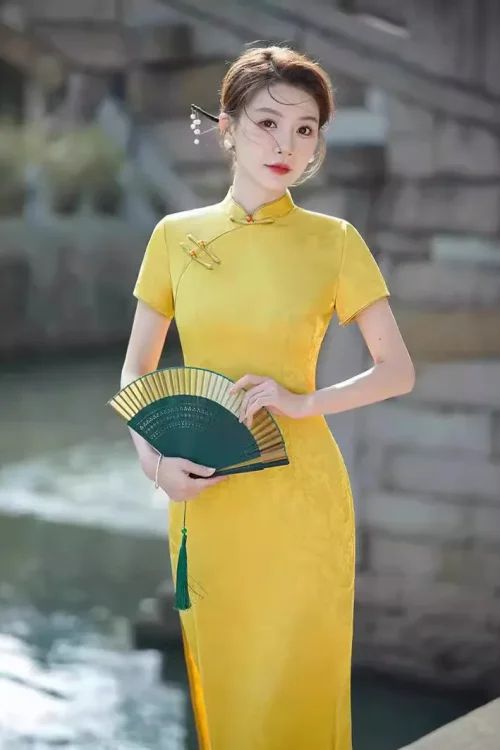Qipao vs. Hanfu: A Historical Comparison
The Resurgence of Traditional Chinese Fashion
In recent years, there has been a growing resurgence of interest in traditional Chinese fashion, particularly in the qipao and hanfu. Both garments have a rich history and cultural significance, but they also have distinct differences that set them apart.
The Qipao
The qipao, also known as the cheongsam, is a form-fitting dress that originated in the early 20th century. It is typically made of silk or satin and features a high collar, side slits, and a fitted waist. The qipao was popularized by Shanghai socialites in the 1920s and 1930s and became a symbol of modern Chinese womanhood.

The Hanfu
The hanfu, on the other hand, is a traditional Chinese robe that has been worn for centuries. It is typically made of cotton or linen and features a loose, flowing silhouette. The hanfu is often decorated with intricate embroidery and is worn for formal occasions such as weddings and festivals.

Historical Context
While both the qipao and hanfu are considered traditional Chinese garments, they represent different periods in Chinese history. The qipao is a product of the early 20th century, a time of rapid social and cultural change in China. The hanfu, however, is a symbol of China’s long and rich cultural heritage.
Cultural Resurgence
In recent years, there has been a growing interest in both the qipao and hanfu. This resurgence is due in part to a growing sense of national pride among Chinese people. It is also due to the increasing popularity of Chinese culture around the world.
Modern Identity
Today, the qipao and hanfu are worn by people of all ages and backgrounds. They are seen as symbols of Chinese identity and culture. The resurgence of these traditional garments is a testament to the enduring power of Chinese fashion.
Future of Traditional Fashion
As the interest in traditional Chinese fashion continues to grow, it is likely that the qipao and hanfu will continue to play an important role in Chinese culture. These garments are not only beautiful and stylish, but they also represent the rich history and heritage of China.
The Cultural Significance of Qipao and Hanfu
Connecting with Heritage
The qipao and hanfu have seen renewed interest, embraced by a new generation eager to connect with their cultural heritage. The qipao, characterized by its high collar and intricate embroidery, has long been associated with elegance and femininity.
Historical Importance of the Qipao
The qipao has been worn by countless Chinese women, including celebrities and political figures. Its popularity reflects the changing status of women in Chinese society, especially during the early 20th century.

The Hanfu’s Legacy
The hanfu, dating back to the Han dynasty (206 BCE – 220 CE), features flowing fabrics and wide sleeves. It has been worn by both men and women throughout history and symbolizes Chinese cultural identity.

Factors Influencing Popularity
The resurgence of interest in qipao and hanfu is tied to a growing sense of national pride among Chinese people. As China becomes more prosperous, citizens are increasingly exploring their cultural roots, leading to renewed appreciation for traditional arts and crafts.
Role of Social Media
Social media platforms like Instagram and Weibo have facilitated the sharing of traditional clothing. This has fostered a sense of community among enthusiasts and inspired others to embrace traditional fashion.
Cultural Impact
The resurgence of these garments signifies a positive development for Chinese culture, showcasing pride in heritage and the continued relevance of traditional fashion in the modern world.
Modern Interpretations of Qipao and Hanfu
Embracing Tradition in Contemporary Fashion
The qipao and hanfu are now being embraced by a new generation eager to connect with their cultural heritage. The qipao, with its form-fitting design, is seen as a staple of Chinese fashion.
The Qipao’s Revival
In recent years, the qipao has undergone a revival, with designers reinterpreting the classic silhouette using modern fabrics and prints, making it versatile for various occasions.

The Hanfu’s Resurgence
Similarly, the hanfu has gained popularity as people seek to reconnect with their cultural roots. Its flowing design and rich history appeal to those wanting to celebrate traditional Chinese aesthetics.

Cultural Representation
While the qipao reflects modern Chinese culture, the hanfu is viewed as a symbol of ancient tradition. Both garments are now celebrated by a new generation eager to honor their heritage.
Global Appeal
The interest in traditional Chinese fashion extends beyond China. The qipao and hanfu have gained popularity internationally as more people discover their beauty and significance.
Versatility in Fashion
Both garments are versatile and can be worn in various settings. The qipao can be dressed up or down, while the hanfu is suitable for everyday wear and special occasions alike.
Conclusion
The resurgence of interest in traditional Chinese fashion is a positive trend that promotes Chinese culture worldwide. The qipao and hanfu are beautiful and elegant garments that can be embraced by people of all ages and backgrounds, solidifying their status as iconic symbols of Chinese culture.
